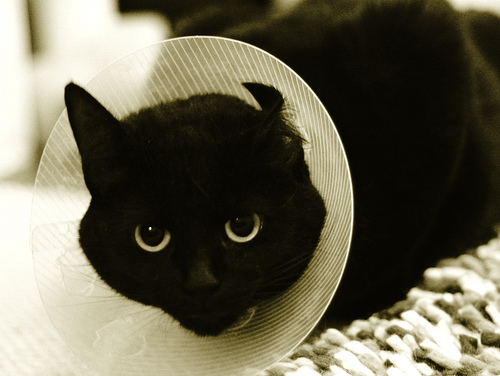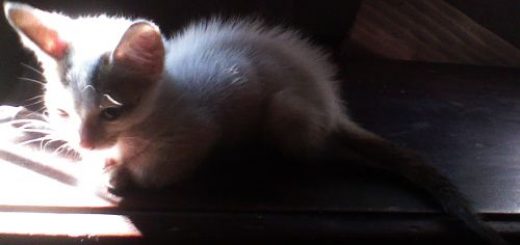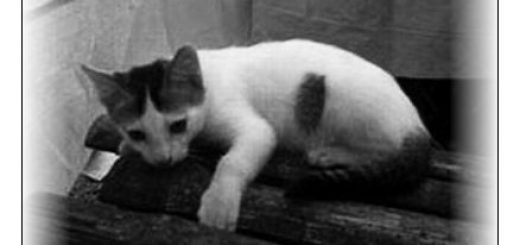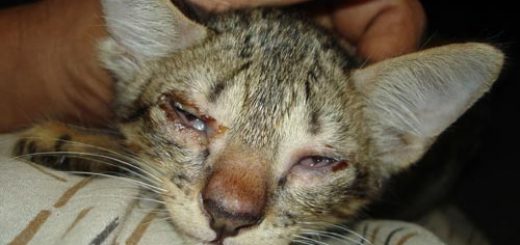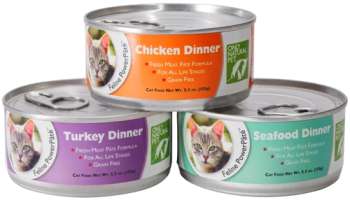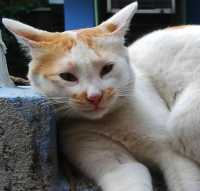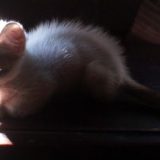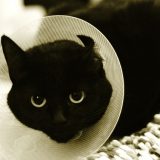[dropcap]I[/dropcap]njury is a commonplace among outdoor cats. If the cat is your pet you might have some luck handling him, but treating a stray is difficult. Fortunately, when the injury is severe, they are too weak to protest, and may be grabbed by the scruff of the neck and put into a basket and carried home for treatment. We have done this several times though not always with a happy ending because, oftentimes, the infection had become too severe to be healed.
[In case you are here redirected from my old site looking for Pulmonary Emphysema in cats, please click here.]
You will need the following when you set out to treat an injury:
- Antibiotic: Azithromycin has worked wonders in my experience even though Gentamycin is supposed to be the drug of choice. I use Azithromycin Oral Suspension 20mg/ml. My preferred brand is Azithral Liquid 100 for Paediatric use, available in 15ml ready to use packs, manufactured by Alembic. Personally, I have not found the other brands as effective.
- Betadine Liquid for washing the wound.
- Negasunt® Dusting Powder in case there are maggots. This is a product of Bayer Healthcare manufactured by Pfizer in India.
- Pincer for pulling maggots (if any) out of the wound.
- Cotton.
Case Study: Almost Completely Severed Paw
[dropcap]T[/dropcap]o cut a long story short, my mom and I put him in a basket and brought him to our cat shelter. One of his hind legs had been injured and the paw was almost gone. The bones were crushed and could be seen jutting out of the pulpy flesh.
This cat was a stray and would often fight with the cats in our shelter, especially with Chew. He was strong and lean and probably the father of Small P, one of our shelter babies. His age might have been around six or seven years at that time. I could not weigh him, but he looked like he was around four kilos.
Mode of Treatment
- Washed wound with Betadine Liquid sprayed through a syringe (needle off)
- Grabbed neck cautiously and force fed 2.5ml Azithral once a day for seven days
- Sprayed Negasunt® on the wound to stop the rot and maggot infestation.
- Boiled fish and milk for food; the first two days he had to be force fed diluted protein powder meant for convalescent humans. We did this several times a day to stop him from getting dehydrated.
[pullquote-right]In time, flesh covered the bones sticking out of his hind leg, and now he limps around just fine and can even run[/pullquote-right]
Once the injury was partially healed he managed to escape from the wire mesh enclosure where he had been kept for treatment. We did not see him for days. Then we began to notice him here and there. At least he was alive. Later, he decided to come to us for food. He has been a regular ever since. He was completely healed. In time, flesh covered the bones sticking out of his hind leg, and now he limps around just fine and can even run. Although a feral, he even allowed me caress him after a few months he first began to come to us for food!
Almost all injuries may be treated like this. The cases that could not be treated, especially the ones where antibiotics could not be administered, were the cases that we lost. Sometimes, if you cannot force feed liquid antibiotic, you may try emptying the contents of Oxytetracycline Capsules in bits of fish. Unfortunately, cats can be picky, and even when they are near death it is not always possible to get ferals to have food in which any kind of medicine has been mixed.
In case of maggot infestation there will be a distinct, rotting stench. After you have dusted the injury with Negasunt®, try to pull out the dead and dying maggots with pincers.
One final word: cats usually lick themselves all over to clean themselves. Their saliva is highly acidic and kills even Tetanus germs – at least that’s what an aged Doctor told me, and I have no reason to not believe him. Do not despair if they lick the wound. It will, of course, take off the medication, but it will also help in the healing process. They are equipped to handle injuries on their own. Sometimes, when things go bad, a little bit of helping hand is all that is required.

[dropcap]H[/dropcap]aving said that, I quote an email that I received in 2011 which gives us a different perspective altogether. I do stand by what I have written but the information in this mail is of vital importance and best not ignored. As the cat’s owner, it is entirely up to you to decide when an open wound can do with a bit of licking and when it has to be protected from the victim’s efforts. I have not mentioned the name of the sender of the email because I received an auto-reply when I responded to her mail asking for her permission to put up her message on my site, and then was too lazy to follow up!
Hi
I am writing to you because I am a very cat mad person myself and am happy to have found your site. Reading up everything on cat illnesses. Very very useful, thank you for putting it up.
I am also writing because you have mentioned something positive about cats licking wounds, which runs deeply contrary to my experience and has in the past endangered one of my cats. therefore this mail is to share with you what happened many years ago.
You’ve written
One final word: cats usually lick themselves all over to clean themselves. Their saliva is highly acidic and kills even Tetanus germs – at least that’s what an aged Doctor told me, and I have no reason to not believe him. Do not despair if they lick the wound. It will, of course, take off the medication, but it will also help to sterilize the wound. They are equipped to handle injuries on their own.
[pullquote-left]I got a frantic call from my mother – there was blood all over the cupboard walls, and on the floor of the room[/pullquote-left]Our tomcat Bhoot – a well built, sleek cat – vanished when he was just about 1+ year old. We searched high and low, to no avail. He dragged himself back 15 days later, shrunken, with a torn ear and deep injuries on the front of his hind legs. We called a vet home, who reassured us all was well and told us to spray the wound with arnica to reduce pain. Bhoot crawled into a cupboard to nurse himself and lick his wounds. We let him.
The next day when I was at work, I got a frantic call from my mother – there was blood all over the cupboard walls, and on the floor of the room. A lot of blood. I rushed Bhoot to a vet, to find that he had burst a vein. How – by licking his wounded flesh! His own tongue had done the damage… The vein was luckily not the main one, and we’d rushed him there in time. the vein had to be cauterised and Bhoot given the drip. A month of dressing his wounds daily, and making him wear a plastic elizabethan collar to prevent him from licking, and he slowly recovered. He’s 3+ now.
In sum, I can vouch for something from experience – the papillae on a cat’s tongue are so sharp they can damage flesh. Yes what the aged doctor said about saliva etc may be true, and may work on minor cuts etc, but that’s not the whole picture with licking – cats can kill themselves with licking a wound, as Bhoot nearly did.
I’m writing to share this with you in the hope that it may help some wounded cat…
thank you once again for your helpful site
warmly
…………………….
Concluding Remarks:
[dropcap]I[/dropcap]deally, you will want to use antibiotic injections for faster healing and at least subcutaneous drip if not intravenous to prevent dehydration. However, cases with ferals are less than ideal. I did not take him to a doctor because even my pets are terrified of the journey: I did not want to traumatize him any more than he already was.
As for asking doctors to come to see him – I have found that Veterinary Doctors are not invariably Animal Lovers. A lot of them are too scared of strays and want to hurry up and finish the examination.
I did consult a doctor though, a very old and nice gentleman by the name of Dr. Professor Mrinal K. Chatterjee, our family physician who passed away in 2010. He is the one who told me about Azithromycin’s use to heal wounds. Prior to that, I knew only that it was effective for Upper Respiratory Tract Infection.
[hr]
In case you are here redirected from my old site looking for Pulmonary Emphysema in cats, here’s what I had appended to the post on Injury and Infection:
This is a very peculiar and fatal disease, and fortunately, the sympotm, at lest in case of my cat, was very clear, and, I might add, weird. When I was petting him, I found a funny crackling noise coming from underneath his coat. That was the sound of air bubbles bursting when I touched him. One or more of the tubules that carry air to and from the lungs was ruptured somehow, and the air had leaked onto the surface of his flesh. Cats and dogs have loose skin, and the air is conveniently stored inside giving rise to funny noises when petted.
Chhoto Hulo got well after a ‘Shotgun Regimen’ of steroids. The drug used went by the brand name of Wysolan. There were no other symptoms apart from the fact that he was lethargic.
This is, once again, a complex problem, and best treated by a medical professional.
I later realized that this should be a detailed article in its own right but never got down to writing it down. If you care to subscribe below, you will receive notification once I publish that post.
_____________________


